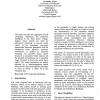Free Online Productivity Tools
i2Speak
i2Symbol
i2OCR
iTex2Img
iWeb2Print
iWeb2Shot
i2Type
iPdf2Split
iPdf2Merge
i2Bopomofo
i2Arabic
i2Style
i2Image
i2PDF
iLatex2Rtf
Sci2ools
EUSFLAT
2001
2001
Intelligent modelling of the indoor climate in buildings by soft computing
The paper considers the application of soft computing techniques for predictive modelling in the built sector. TakagiSugeno fuzzy models are built by subtractive clustering to provide initial values of the antecedent non-linear membership functions parameters and the consequent linear algebraic equations coefficients. A method of extensive searching the possible fuzzy model structures is presented which explores all the possible permutations for a specified range of orders to derive the initial fuzzy model. The model parameters are further adjusted by a back-propagation neural network and a real-valued genetic algorithm in order to obtain a better fit to the measured data.
| Added | 31 Oct 2010 |
| Updated | 31 Oct 2010 |
| Type | Conference |
| Year | 2001 |
| Where | EUSFLAT |
| Authors | Alexander Gegov |
Comments (0)

